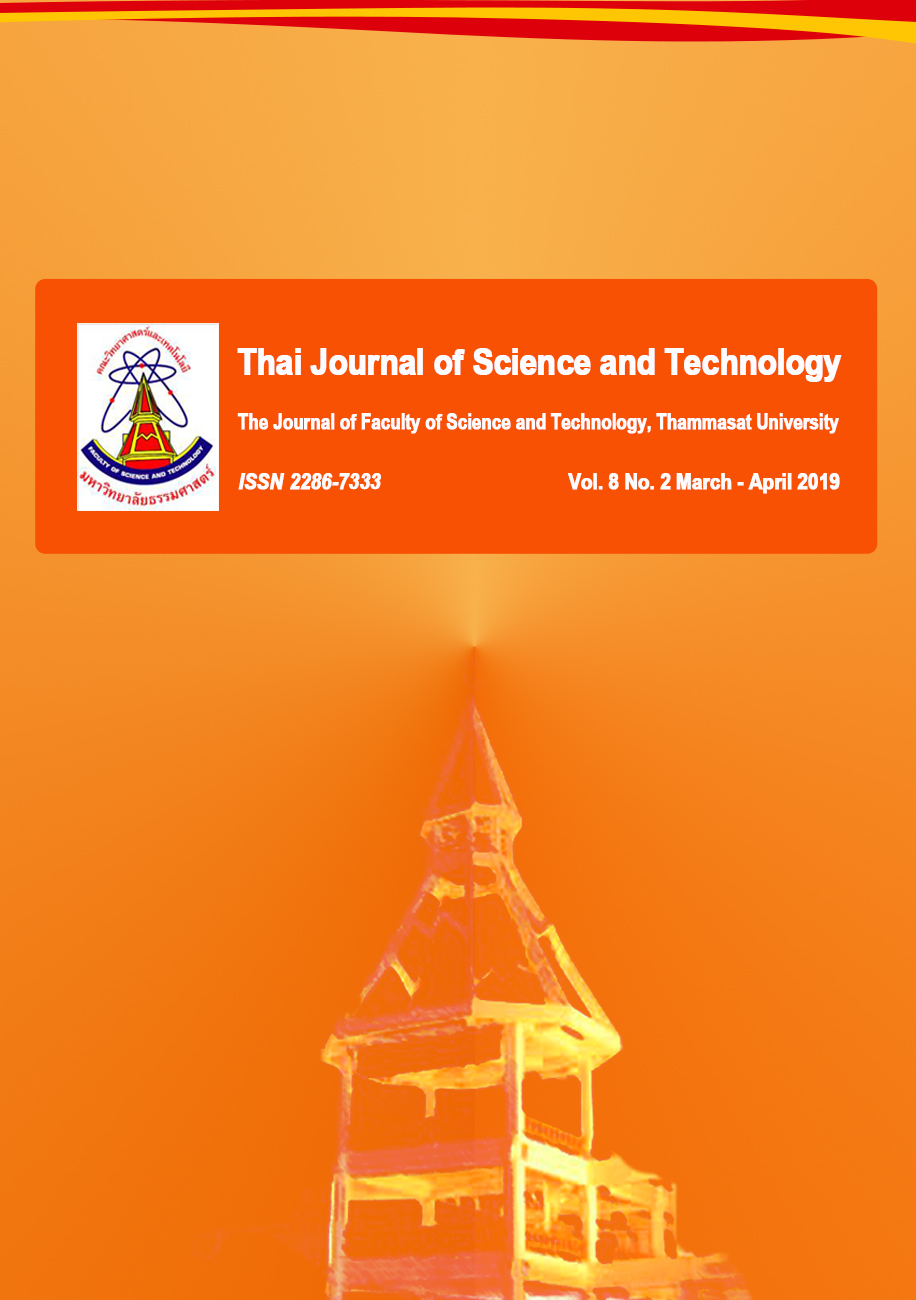ผลของการใช้สารเสริมชีวภาพ (DS-1) ในอาหารไก่เนื้อต่อเปอร์เซ็นต์ชิ้นส่วนตัดแต่งและคุณภาพเนื้อ
Main Article Content
Abstract
Abstract
The objective of this study was to study the effects of synbiotic product (DS-1) supplementation in broilers diets on retail cut percentage and meat quality. A total of 240 broilers chicks was arranged in completely randomized design with allocated into 5 dietary treatments with 8 replications. The dietary treatments were commercial feed (control diet), commercial feed supplemented with 0.5, 1.0, 1.5 and 2.0 % of synbiotic product (DS-1), respectively. The results showed that retail cut percentage, meat quality, proximate analysis, cooking loss, shear force, juiciness and total plate count of broilers were not significantly different (p > 0.05), whereas the increased color values of breast meat (L*, a* and b*) were significantly different (p < 0.05). The synbiotic product (DS-1) at 0.5, 1.0 and 2.0 levels decreased the TBARS value (p < 0.05). The results of the experiment concluded that synbiotic product (DS-1) supplemented in diets had not effects on the retail cut percentage, meat quality and proximate analysis of broilers. However, synbiotic product (DS-1) at 1.5 level is effective to increase the color values (L*, a* and b*) in raw chicken meats during a period of storage.
Keywords: antioxidant; antimicrobial; period of storage
Article Details
บทความที่ได้รับการตีพิมพ์เป็นลิขสิทธิ์ของคณะวิทยาศาสตร์และเทคโนโลยี มหาวิทยาลัยธรรมศาสตร์ ข้อความที่ปรากฏในแต่ละเรื่องของวารสารเล่มนี้เป็นเพียงความเห็นส่วนตัวของผู้เขียน ไม่มีความเกี่ยวข้องกับคณะวิทยาศาสตร์และเทคโนโลยี หรือคณาจารย์ท่านอื่นในมหาวิทยาลัยธรรมศาสตร์ ผู้เขียนต้องยืนยันว่าความรับผิดชอบต่อทุกข้อความที่นำเสนอไว้ในบทความของตน หากมีข้อผิดพลาดหรือความไม่ถูกต้องใด ๆ
References
มนัสนันท์ นพรัตน์ไมตรี, กฤติยา เลิศชุณหเกียรติ, จิรัฎฐวัฒน์ ศรีอ่อนเลิศ และวรางคณา กิจพิพิจ, 2557, ผลของการเสริมโปรไบโอติกส์ (แบคโตแซค®) ในน้ำดื่มต่อการย่อยได้ของโภชนะ สัณฐานวิทยาของลำไส้เล็ก เปอร์เซ็นต์ซาก และคุณภาพเนื้อของไก่เนื้อ, แก่นเกษตร 42(2): 221-230.
AOAC, 1995, Official Methods of Analysis, 16th Ed., AOAC International, Gaithersburg. Bourne, M.C., 1978, Texture profile analysis, Food Technol. 32: 62-66.
Brake, J., Havenstein, G.B., Scheideler, S.E., Ferket, P.R. and River, D.V., 1993, Relationship of sex, age, and body weight to broiler carcass yield and offal production, Poult. Sci. 72: 1137-1145.
Buege, J.A. and Aust, S.D., 1978, Microsomal lipid oxidation, Method Enz. 52: 302-304.
Hossain, M.E., Kim, G.W., Lee, S.K. and Yang, C.J., 2012, Growth performance, meat yield, oxidative stability, and fatty acid composition of meat from broiler fed diets supplemented with a medicinal plant and probiotics, Asian-Aust. J. Anim. Sci. 25: 1159-1168.
Jin, L.Z., Marquard, R.R. and Zhao, X., 2000, A strain of Enterococcus faecium (18C23) inhibits adhesion of enterotoxigenic Escherichia coli K88 to porcine small intestine mucus, World Appl. Env. Microbiol. 66: 4200-4204.
Khaksefidi, A. and Rahimi, Sh., 2005, Effect of probiotic inclusion in the diet of broiler chicken on performance, feed efficiency and carcass quality, Asian-Aust. J. Anim. Sci. 18: 1153-1156.
Kleter, G.A. and Marvin, H.J., 2009, Indicator of emerging hazards and risk to food safety, Food Chem. Toxicol. 47: 1022-1039.
Lyon, C.E., Papa, C.M. and Wilson, R.L., 1991, Effect of feed withdrawal on yields, muscle pH, and texture of broiler breast meat, Poult. Sci. 70: 1020-1025.
Marquardt, R.R., Brenes, A., Zhang, Z. and Boros, D., 1996, Use of enzyme to improve nutrient availability in poultry feedstuffs, Anim. Feed Sci.Technol. 60: 321-330.
Nardonea, A. and Valfre, F., 1999, Effects of changing production method on quality of meat, milk and egg, Livest. Prod. Sci. 59: 165-182.
Nathapol, O., 2010, DS-1 Information. Micro INNOVATE Co., Ltd., Ratchaburi. Pearson, D., 1976, The chemical analysis of foods, 6th Ed, Churchill Livingstone, London.
Pelicano, E.R.L., Souza, P.A., Souza, H.B.A., Oba, A., Norkus, E.A., Kodawara, L.M. and Lima, T.M.A., 2003, Effect of different probiotics on broiler carcass and meat quality, Braz. J. Poult. Sci. 5: 207-214.
Renden, J.A., Bilgili, S.F., Lien, R.J. and Kincaid, S.A., 1991, Live performance and yields of broilers provided various lighting schedules, Poult. Sci. 70: 2055-2062.
Sallam, K.I. and Samejima, K., 2004. Microbiological and quality of beef treated with sodium lactate and sodium chloride during refrigerated storage, J. Lebensm. Wiss. U. Technol. 37: 865-871.
Shu, Q. and Gill, H.S., 2001, A dietary probiotic (Bifidobacterium lactis HN019™) reduces the severity of Escherichia coli O157:H7 infection in mice, Med. Microbiol. Immunol. 189: 147-152.
Smith, E.R. and Pesti, G.M., 1998, Influence of broiler strain cross and dietary protein on performance of broilers, Poult. Sci. 77: 276-281.
Snel, J., Harmsen, H.J.M., Van, J.J., Wielen, P.W.J.J. and William, B.A., 2002, Dietary strategies to influence the gastro-intestinal micro flora of young animal and its potential to improve intestinal health, AGRIS Sci. 1: 37-69.
Thursby, E. and Juge, N., 2017, Introduction to the human gut microbiota, Biochem. J. 474: 1823-1136.
Wattanachant, S., Benjakul, S. and Ledward, D.A., 2004, Composition, color and texture of Thai in-digenous and broiler chicken muscles, Poult. Sci. 83: 123-128.
Zhou, X., Wang, Y., Gu, Q. and Li, W., 2010, Effect of dietary probiotic, Bacillus coagulans, on growth performance, chemical composition, and meat quality of Guangxi Yellow chicken, Poult. Sci. 89: 588-593.


